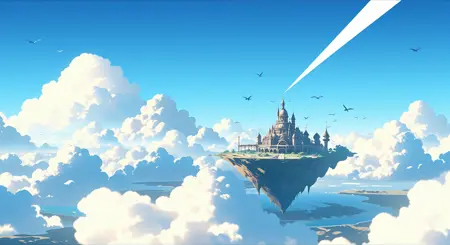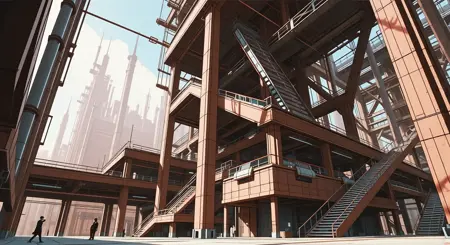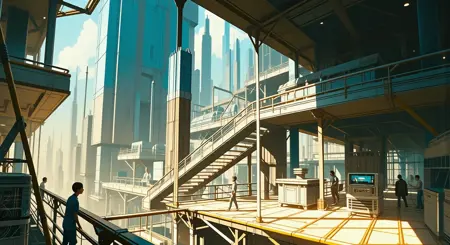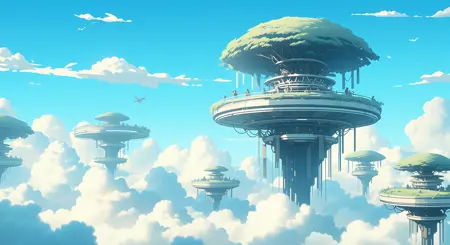DJZ Airships V2 Cities
Details
Download Files
Model description
part of the collection:
Image Model Prompt Analysis Report
Overview
This report analyzes a collection of prompts used to train a generative image model. The dataset consists primarily of detailed image descriptions that appear to focus on two main categories:
Floating sky cities/islands with futuristic or fantasy elements
Industrial/mechanical city environments
Common Trigger Words and Their Associations
Primary Trigger Words
"qpq": This appears to be a specific trigger word associated with floating cities and sky islands. Every prompt containing "qpq" describes some variation of a floating city or island suspended in the sky.
"anime": Present in all prompts, indicating the stylistic approach for the generated images - an anime/manga art style.
Secondary Trigger Phrases
"floating in the sky": Consistently paired with "qpq" to generate floating cities, islands, or structures.
"surrounded by blue sky, above white clouds": A standard phrase in the floating city prompts that establishes the environmental setting.
"in the background machine city": Trigger phrase for industrial, mechanical, or futuristic city environments with complex machinery.
Descriptive Elements and Their Associations
For Floating Cities ("qpq" prompts):
"otherworldly": Appears in nearly every floating city description, often paired with descriptors like "serene," "beautiful," or "atmosphere"
"lush greenery": Common element in floating cities, suggesting integration of nature with technology
"futuristic cityscape": Frequently used to describe the architectural style
"circular": Common architectural element in these floating structures
"platforms": Structural component frequently mentioned for floating cities
"atmosphere": Term used to describe the overall mood, often paired with "otherworldly"
For Machine Cities:
"futuristic industrial setting": Standard opening description
"towering structures": Describes vertical architectural elements
"intricate machinery": Emphasizes detail and complexity
"metallic": Common material descriptor
"color palette": Often specifically mentioning purple, red, orange, and blue tones
"platforms and walkways": Common structural elements
Prompt Structure Analysis
The prompts follow consistent structural patterns:
Pattern 1: Floating City Prompts
anime qpq city floating in the sky, surrounded by blue sky, above white clouds. [Detailed description of a floating city/island with specific architectural details, environmental elements, lighting, and mood]
Pattern 2: Machine City Prompts
anime in the background machine city. [Detailed description of an industrial/mechanical setting with specific structural elements, color palettes, lighting, and atmosphere]
Visual Elements Spectrum
The analyzed prompts reveal a spectrum of visual elements that the model has been trained to generate:
Architectural Elements:
Circular platforms
Multi-tiered structures
Towers and spires
Bridges and walkways
Cylindrical buildings
Castle-like structures
Pagodas and traditional East Asian architecture
Industrial pipes and machinery
Staircases and platforms
Metallic surfaces
Environmental Elements:
Clouds (white, fluffy)
Clear blue skies
Reflective water surfaces
Lush greenery and vegetation
Trees integrated with structures
Stars and cosmic elements
Various lighting conditions (day/night)
Color Palettes:
Floating cities: Blues, whites, greens, with pastel accents
Machine cities: Purples, reds, oranges, and metallic tones
Mood/Atmosphere Descriptors:
"Serene"
"Otherworldly"
"Vibrant"
"Dreamlike"
"Surreal"
"Majestic"
"Complex"
"Advanced"
"Ethereal"
"Futuristic"
Capability Map
Based on the analysis, this image model appears capable of generating:
Fantasy Environments
Floating islands with castle-like structures
Whimsical villages suspended in clouds
Nature-rich floating landmasses
Futuristic Environments
Advanced floating cities with technological elements
Space station-like structures
Industrial mechanical complexes
Architectural Styles
East Asian-inspired fantasy architecture
Futuristic sci-fi structures
Cyberpunk/steampunk industrial settings
Organic-technological hybrid designs
Atmospheric Conditions
Daytime cloudy skies
Starry night environments
Sunset/twilight settings
Integration of Nature and Technology
Gardens and greenery embedded in futuristic structures
Trees and plants growing on floating islands
Natural elements contrasted with mechanical components
Pattern Recognition and Prompt Engineering Insights
Trigger Specificity: The "qpq" trigger is extremely specific in generating floating city imagery, while "machine city" consistently produces industrial environments.
Descriptor Impact: Terms like "otherworldly," "serene," and "complex" are consistently used to establish mood and appear to be effective emotional/atmospheric cues for the model.
Structural Repetition: Many prompts follow nearly identical opening structures but achieve varied outputs through the detailed descriptions that follow.
Redundant Adjectives: Many descriptions contain repeating or near-synonym adjectives ("otherworldly atmosphere ambiance"), suggesting the model may benefit from redundancy in emphasis.
Detailed Specificity: Prompts with the most detailed architectural and environmental specifications seem designed to produce the most controllable outputs.
Conclusion
This analysis reveals a generative image model with capabilities focused primarily on creating anime-style floating cities/islands and industrial mechanical environments. The prompt collection demonstrates a systematic approach to training with clearly defined trigger words ("qpq" and "machine city") that activate specific visual themes.
The model appears to have strong capabilities in generating:
Fantasy and sci-fi environments with specific architectural elements
Integration of natural and technological elements
Varied atmospheric conditions and moods
Complex structural details, particularly in mechanical/industrial settings
The consistent structure and repetitive nature of the prompts suggest this is a carefully curated training set designed to establish reliable trigger words that produce consistent thematic outputs while allowing for variation in specific details.






